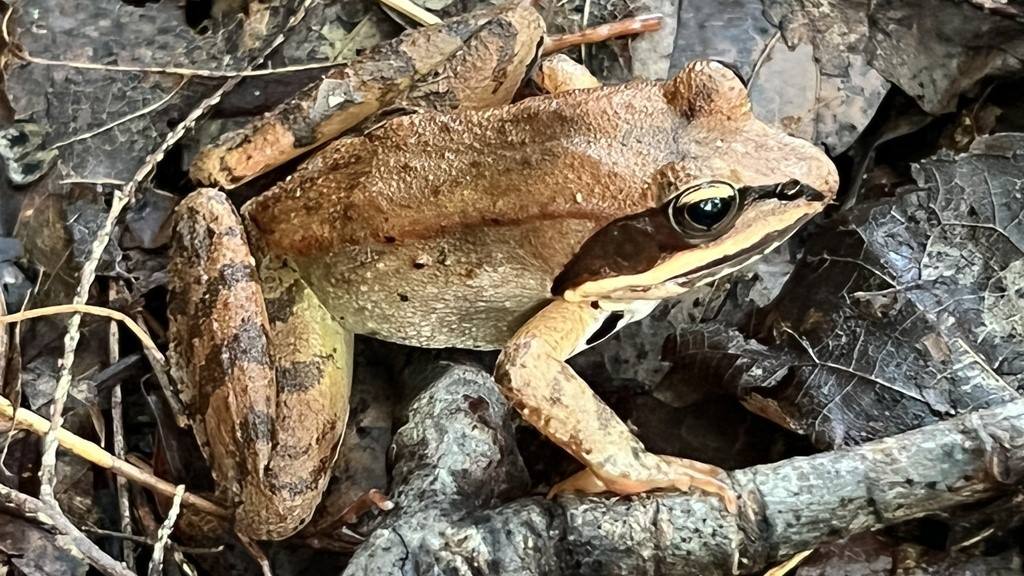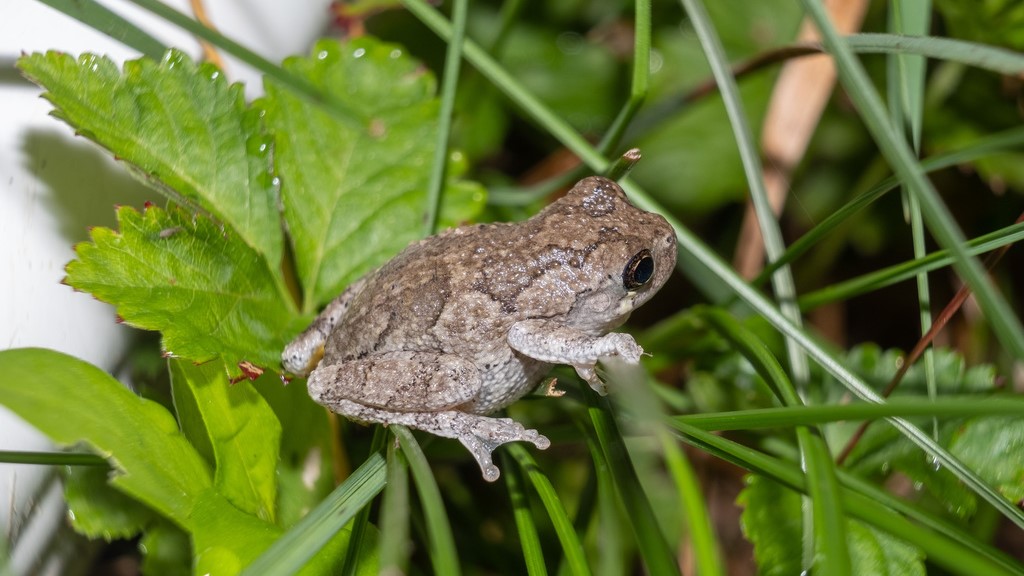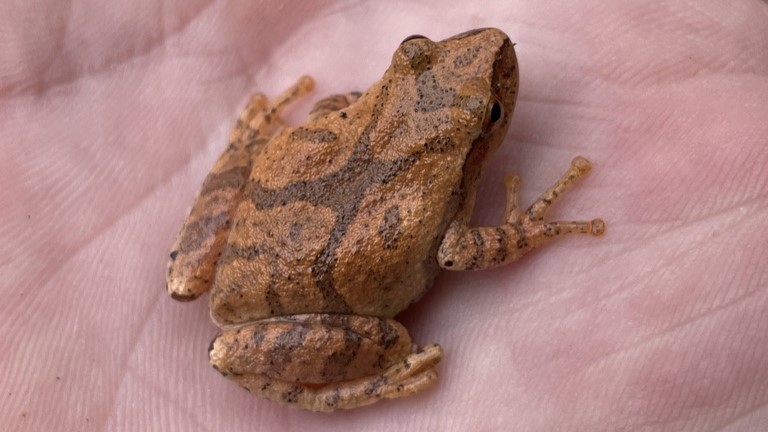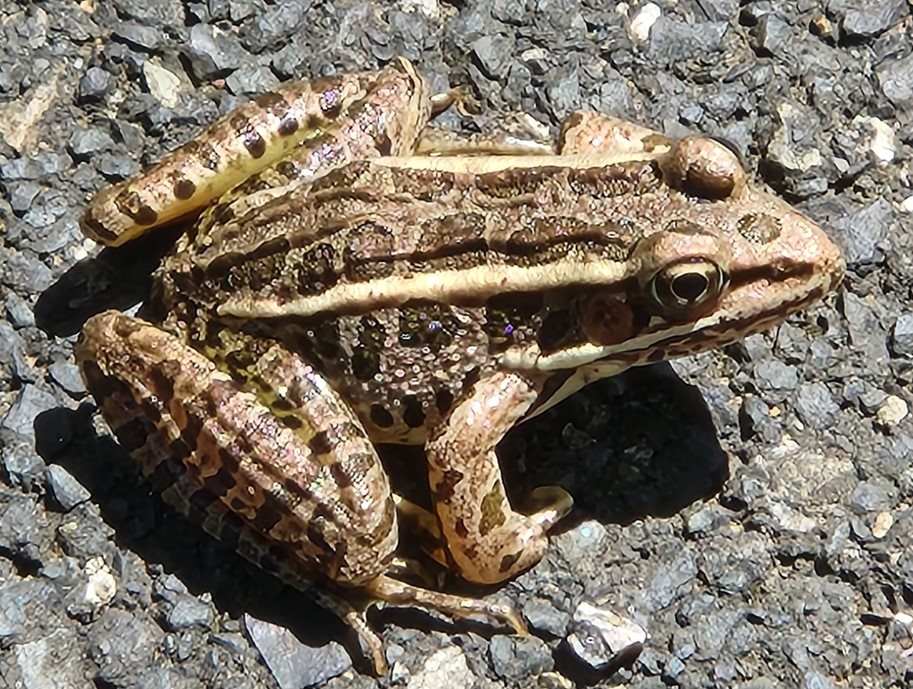There are nine types of frogs in Maine, among the fewest species found in any state. A big part of this is the climate: southern states with shorter and more mild winters host a greater degree of amphibian diversity. In Northern New England, our frog and toad friends must find a way to survive frigid winters — and the species of Maine have devised ingenious ways to do just that.
There are six true frogs in the state, two tree frogs, and a single toad. This ID guide is intended to help you assess which frog or toad species you may have encountered — or it can be used to start learning key characteristics of these species. If you’d like to narrow your focus to calls, consider this guide to Maine frog sounds.
In addition to this guide, I’d highly recommend that you check out the Maine Department of Fisheries and Wildlife’s page on reptiles and amphibians. For an excellent field guide, consider the Peterson’s Guide to Amphibians of Eastern North America.

TERMINOLOGY
The guide below includes some terminology that may not be familiar to everyone. You might start by checking out this diagram, which will help with several of the following terms:
- Length refers to snout-vent length: the distance from the snout to the groin. It does not include the legs.
- “Above” refers to the side of the frog visible when you, the observer, view it from above — the dorsal or “back” side of the frog.
- Dorsolateral ridges are the two folds that run along a frog’s back, roughly between the shoulders and the hind legs. For this and
- Tympanum is another name for the ear drum, which is the circle behind each eye.
- Parotoid glands are bumps behind toads’ eyes that can excrete bufotoxins, which nhelp protect them from predators. (These toxins are not are not dangerous to touch, but they can cause severe harm if ingested; more info here.)
FROG ID GUIDE INSTRUCTIONS
The guide below includes all the frogs found in Maine. If you want to narrow your search, select the button that best matches the amphibian you saw. If you aren’t sure of a particular characteristic, you can select nothing (which will keep all options open) or choose multiple categories (to narrow to those criteria).
American Toad
Lithobates americanus

| Family: Bufonidae (true toads) |
| Description: Length 2 – 3.5″. Brown, gray, green, or even reddish above, with patches of light colors. Dark spots with one or two warts in each. Belly white and usually spotted. Parotoid glands are separate from ridges behind eyes, or connected with spurs. No dorsolateral ridges. |
| Mating Call: High-pitched musical trill that lasts between 5 and 30 seconds. [video] |
| Habitat: Forests, backyards, gardens, breed in shallow bodies of water. |
| Additional Info: Species account; photos |
Gray Treefrog
Hyla versicolor, Hyla chrysoscelis

| Family: Hylidae (tree frogs) |
| Description: Length 1.25 – 2″. Camouflaged gray, green, brown, or even white to match surroundings, often with irregular dark spots or blotches above. Dark-bordered light patches beneath eyes. Underside of hind limbs yellowish orange. Belly is white. No dorsolateral ridges. Eastern Gray Treefrog (H. versicolor) and Cope’s Gray Treefrog (H. chrysoscelis) are visually identical. |
| Mating Call: A musical trill that lasts about half a second and is repeated every few seconds. The pulse rate (speed of the call notes) of Cope’s Gray Treefrog is faster and sounds harsher than the Eastern Gray Treefrog in areas where the species overlap. [video] |
| Habitat: Woods and edges of woods, usually near water. |
| Additional Info: Species profile; photos |
Spring Peeper
Pseudacris crucifer

| Family: Hylidae (tree frogs) |
| Description: Length 0.75 – 1.25″. Typically brown, grayish, or olive above, with dark markings between eyes and a dark, X shape in center of back. Toepads are wider than the toes. Belly is light colored. No dorsolateral ridges. Males have swollen thumbs and dark throats during breeding season. |
| Mating Call: High “peep” sound that ascends in pitch at the end, and lasts about a second. Chorus can be deafeningly loud in breeding season. Peepers are much more commonly seen than heard. [video] |
| Habitat: Wet forested areas, especially where shallow water is nearby. |
| Additional Info: Species profile; photos |
American Bullfrog
Lithobates catesbeianus

| Family: Ranidae (true frogs) |
| Description: Length 3.5 – 6″. Largest frog in the state. Green above, sometimes with dark blotches. Belly white, sometimes with gray blotches and yellowish tint. Upper lip green. Dark stripes on legs. No dorsolateral ridges. Males have tympanum larger then eye; tympanum and eye the same size in females. Breeding males have yellowish throats, and enlarged thumbs. |
| Mating Call: Series of “ruummm” calls, sometimes sounds like “jug-o-rum”. [video] |
| Habitat: Found in wide variety of aquatic habitats, including lakes, ponds, swamps, marshes, slow-moving streams, vernal pools. |
| Additional Info: Species profile; photos |
Green Frog
Lithobates clamitans

| Family: Ranidae (true frogs) |
| Description: Length 2 – 3″. Green, greenish brown, brown, or bronze above, sometimes with dark blotches. Often has a green upper lip. Belly is white with dark blotches or net-like marks. Dorsolateral ridges present. Legs have dark stripes. Males have tympanum larger than eye and yellow throats. |
| Mating Call: Sounds like a loose banjo string being plucked; a loud “gunk!”. [video] |
| Habitat: Permanent bodies of water, including swamps, ponds, and small streams. |
| Additional Info: Species profile; photos |
Pickerel Frog
Lithobates palustris

| Family: Ranidae (true frogs) |
| Description: Length 1.75 – 3″. Light brown, sometimes with a greenish hue. Rectangular spots on back arranged in two parallel rows between dorsolateral ridges. Bright yellow or orange under hind limbs. Belly is white in northern states, but may have dark blotches in some southern populations. |
| Mating Call: Low-pitched, descending snore that lasts about two seconds. [video] |
| Habitat: Bogs, rocky ravines, meadow streams, other areas with cold, clear water. |
| Additional Info: Species profile; photos |
Northern Leopard Frog
Lithobates pipiens

| Family: Ranidae (true frogs) |
| Description: Length 2 – 3.5″. Green or brown above, with a rounded snout and light line on the upper lip. Usually has a dark spot on top of the snout. Two or three rows of irregular roundish spots randomly distributed between dorsolateral ridges. Spots have light-colored halos. Bellies are white. |
| Mating Call: Snore that rises and then falls in volume, and typically lasts three or more seconds. Interspersed with one or three grunts. [video] |
| Habitat: Marshes, bogs, ponds, floodplains, lakes. |
| Additional Info: Species profile; photos |
Mink Frog
Lithobates septentrionalis

| Family: Ranidae (true frogs) |
| Description: Length 1.8 – 2.75″. Green or brown above, with dark spots, blotches, or net-like pattern. Usually has green on the upper jaw. Dark, somewhat rectangular marks on hind limbs, with the long edge roughly parallel to the limb. Dorsolateral ridges may be present, partial, or absent. Belly white or yellowish. Males have tympanums larger than eyes and yellowish throats. May emit musky scent when picked up. |
| Mating Call: Between two and four abrupt notes in a row, like someone tapping on wood. [video] |
| Habitat: Cold bodies of water, including ponds, lakes, and bogs. |
| Additional Info: Species profile; photos |
Wood Frog
Lithobates sylvaticus

| Family: Ranidae (true frogs) |
| Description: Length 1.3 – 2.75″. Brown, copper-colored, or tan, with a dark mask that starts as a thin line between the snout and eyes and extends as a wider band over the tympanum to the shoulders. White upper lip. Groin is often yellowish. Dorsolateral ridges present. Females are lighter colored, more reddish, and larger than males. |
| Mating Call: Hoarse call that resembles a quacking or clucking duck. [video] |
| Habitat: Edges of ponds and streams in forests, vernal pools. |
| Additional Info: Species profile; photos |
